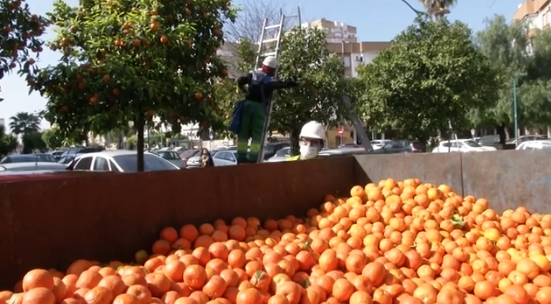03:03

Orange trees lining the streets create a typical postcard image of Seville but as well as being a tourist attraction, the fruit is now being used to produce green electricity for the city.
The southern Spanish city, famed as the heartland of flamenco music, turns orange in spring with the Seville region having some of the largest orange groves in Europe.
But these bitter oranges – native to Southeast Asia and spread by humans across the globe – are rarely consumed in Seville.
Some of the bitter fruit from the city's almost 50,000 orange trees are exported to the UK, where they are made into marmalade.
READ MORE
Hunting a universal coronavirus vaccine
The app aiming to tackle climate change
Iceland volcano erupts – after 800 years
But the rest is often left to fall on city streets, where they rot and can be a public nuisance as they get squashed by car wheels, cause people to slip and attract flies and insects.
"It is one of the trees that most represents the image of the city, and one of its tourist attractions," says David Guevara from Seville city council.
"Above all, because of the smell of orange blossom in spring that makes many people come to the city. But also, when the fruit falls to the ground, it generates difficulties and many problems for citizens."
Now, the city is turning this nuisance into clean energy.
Seville's water utility company Emasesa started a pilot scheme that uses citrus from the city's streets to generate clean energy that runs one of its purification plants.
"We realized the orange that is only used in a residual way for the production of marmalade – this bitter orange is historically very appreciated in the United Kingdom," said city mayor Juan Espadas. "With both the juice and the peel, there is the possibility of combining them with sewage waste to generate energy."

A pilot scheme in Seville involves using oranges to make electricity at a water purification plant. /AP
A pilot scheme in Seville involves using oranges to make electricity at a water purification plant. /AP
First, the oranges are collected and transported to a facility that generates electricity from organic matter. As the oranges ferment, the methane captured is used to drive a generator.
Benigno Lopez, head of Emasesa's environmental department, says they have also trialled olives and sewage water as part of the project.
"Oranges are the last of the [organic] residues we are testing. We have been testing oranges for [the past] two years," he said.
"This year, we have valued 60,000 kilograms with which we are going to produce the energy equivalent to 300 homes in one single day."
Results of the pilot test suggest a ton of oranges can produce up to 50 kilowatt-hours of electricity – enough to power five homes for one day.
Emasesa says if all Seville's oranges were harvested, they could create enough electricity to power 73,000 homes.
Methane obtained from the fruit's juice is used to generate the electricity, while the skin and pips are used to make organic fertilizer for farmland and gardens.
"Fifty percent of that orange is juice," said Lopez. "Through this juice we generate a gas that is rich in methane that we use to produce energy through a cogeneration engine. It is a very simple process.
"It is a process that does not require any type of additives, it is an environmentally controlled process and it closes the circular economy of urban waste, which also means that this facility contributes to the mitigation of climate change by self-sufficient energy."
The energy generated is currently being used to power a city water purification plant, providing Seville with clean drinking water. But bosses have further plans, including using it to power environmentally friendly transportation.
"Our goal is to use waste such as oranges to produce our own electrical energy and reduce our energy consumption needs, either in public transport or for cleaning our waters," said Espadas.
Source(s): AP

